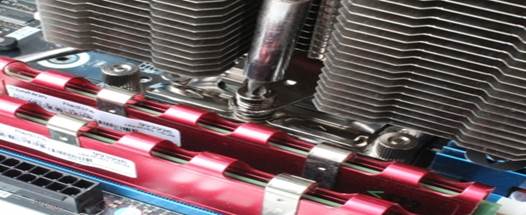Compatibility and Installation
The SilverStone Heligon HE02 can be
installed in any modern platform: Intel LGA 775/1155/1156/1366/2011, Socket AM2
(+) / AM3 (+) / FM1 (2). As a feature of the CPUs, the manufacturers have
limited their highest TDP of 95 watts in fan mode and 130 when you see your
Heligon 02 with a fan. It sounds promising.
First, you have to insert a silver lining
in LGA 2011 socket’s mounting hole.

Installing
the product
Take a little thermal grease and paste it
on the cooler. It is protected with the plates, with screws tightened fit. You also
need a screwdriver to proceed with the installation process.

Installing
the product
Pressure seemed to be high and the fixed
splints were added to stabilize the cooler, preventing it from swaying and
moving aside the CPU.
After installing the SilverStone Heligon
HE02 into the mainboard, we measured the distance between the first heat sink fin
and the last one. The distance was 50 mm. This distance is sufficient for the
cooler not to conflict with the radiators of the electronic components inside
the system and memory.

The
installation process is completed
Heligon HE02 looked very bulky and
promising in our experiments:

The
installation into the computer is completed
Let's see what it can do in the following
experiment.
Configuration and test methods
We tested all the coolers in a close case
with the following parameters:
·
Motherboard: Intel Slider DX79SI (Intel X79
Express, LGA 2011, BIOS 0537)
·
CPU: Intel Core i7-3960X Extreme Edition 3.3
GHz, 1.2 V, 6x256 KB L2, 15 MB L3 (Sandy Bridge-E, C1, 32 nm)
·
The cooling surface: ARCTIC MX-4
·
Graphics: AMD Radeon HD 7770 1 GB GDDR5 128 bit,
1000/4500 MHz
·
System Memory: DDR3 4x4GB Mushkin Redline (Spec:
2133 MHz / 9-11-10-28 / 1.65 V)
·
System Hard Drive: Crucial m4 256 GB SSD
·
Drive for programs and games: Western Digital
VelociRaptor (300GB, SATA-II, 10000 RPM, 16MB cache, NCQ) inside Scythe Quiet
Drive 3.5'' HDD silencer and cooler
·
Backup drive: Samsung Ecogreen F4 HD204UI?
(SATA-II, 2 TB, 5400 RPM, 32 MB, NCQ)
·
Chassis: Antec Twelve Hundred (on the front:
three Noiseblocker NB-multiframe S-Series MF 12-S2 fans at1020 RPM; on the back:
two Noiseblocker NB fan-BlackSilent PRO PL-1 fans at 1020 RPM; on the top : the
standard 200 mm fan at 400 PRM)
·
Control panel: Zalman ZM-MFC3
·
Source: Seasonic SS-1000XP Active PFC F13 1000 W
(with default fan 120 mm)
We gently adjusted
the test methods for the fanless SilverStone Heligon HE02. First, to test the
cooling performance in passive mode, we lowered down all the system fan speeds to
600 RPM in order to reduce the noise to the maximum extent possible and
eliminate the effect of the internal air flow into the cooler. Then, we
determined the largest drive frequency of the overclocked processor step by
step. We will discuss them in the next section of this review.
To prepare for the testing process with the
cooling fans, we used the standard method and all the system fan speeds were
running at their default speed. However, we had to overclock the 6-corer processor
at the operation speed of the clock set at 125 MHz, multiplied at 34x and
"load line calibration" allowed at 4.25 GHz. The nominal Vcore of the
processor was raised to 1.35 V in the BIOS of the mainboard. The "Turbo
Boost" technology was disabled during the testing process, and the
Hyper-Threading technology was used to increase heat dissipation. The memory
voltage was at 1.65 V and its frequency was 2,000 MHz with timing parameters of
9-11-10-28. All other parameters were available in the BIOS of the mainboard
and related to the overclocking process of the CPU or the memory remained
unchanged.
All the testing was conducted under the
Windows 7 Ultimate x64 SP1 operating system. We used the following software in
the experiment:
·
LinX AVX Edition version 0.6.4 - to open the
processor (memory -4500 MB Problem Size -24 234, 2 circles, each lasting 11
minutes);
·
Real Temp GT version 3.70 - to control the
temperature of the processor;
·
Utility Intel Extreme Tuning version 3.1.201.5 -
to control and observe the parameters of the system during overclocking.
Therefore, the
complete image in the testing process looked like this:

The
image of the testing process
The CPU was opened by Linx AVX two
consecutive times with the settings as mentioned above. The period of time that
the CPU temperature was stable between the two tests was approximately 8-10
minutes. We took the highest temperature of the CPU to show on the result chart.
Moreover, we also offered a table with the temperature index for all the cores
including the average values of them. The ambient temperature was checked
through the chassis with an electric thermometer with the precision of 0.1
degrees Celsius, which allowed the process to monitor hourly the temperature
change during the passing 6 hours. The room temperature during testing ranged
from 23.4 to 23.8 degrees Celsius.
We will compare the cooling performance
between the SilverStone Heligon HE02 with the Thermalright TRUE Spirit 120 with
default TY-140 in two operating modes: the maximum rotation speed and in quiet
mode at 800 RPM:

Thermalright
TRUE Spirit 120
We also tested the SilverStone Heligon HE02
with similar TY-140 fans. We also tested it with 120mm Corsair AF120 fan at
ranges from 800-1600 RPM. The rotation speed of all fans was controlled using a
special control device to adjust the voltage of 0.5 V each time:

The
voltage regulators